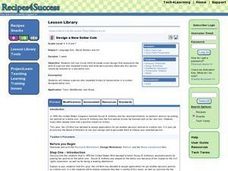National Endowment for the Humanities
Slavery and the American Founding: The "Inconsistency Not to Be Excused"
High schoolers examine slavery in the revolutionary and colonial eras of the United States. In this slavery lesson, students investigate the presence of slavery in early America, the language of the Constitution, and the intent of the...
Library of Virginia
Antebellum Freedom
From indentured servitude to involuntary race-based servitude, slavery has taken many forms in American history. Class members examine three manumission petitions that reveal how the rights of African Americans and African American...
Curated OER
Knowledge is Power
Students explore the distinct forms of knowledge that enslaved Africans brought with them to America or developed while enslaved. They study how political movements of the 18th century helped develop abolitionist thinking.
Curated OER
Integrity - Stanton Style
Learners explore the contributions of Elizabeth Cady Stanton. In this character education lesson, students read a handout regarding Stanton's life. Learners respond to discussion questions regarding her philanthropic work.
Curated OER
Harriet Tubman Warns "Kill the Snake Before It Kills You"
Harriet Tubman developed a rich extended metaphor for slavery and the imperative for Lincoln to abolish it in this dictated letter from 1862. Young historians read the original document and interpret Tubman's allegory with a pair of...
Teacher Created Resources
Angelina and Sarah Grimke: Sisters of Social Reform
Who are the Grimke sisters? Scholars find out with a worksheet that details the struggles and triumphs of the lives of Angelina and Sarah Grimke. After reading an informational text, class members have the opportunity to show what they...
Anti-Defamation League
Harriet Tubman on the $20 Bill: The Power of Symbols
How important are symbols and symbolic gestures in society? Middle schoolers have an opportunity to analyze the importance of symbols on American currency with a lesson plan that investigates the controversies surrounding redesigning the...
Curated OER
Fredrick Douglass...A Digital History
Seventh graders research the life of Fredrick Douglass. In this Fredrick Douglass lesson, 7th graders read about his life and discuss it. They write poetry describing his experience as a slave and create their own monument for Fredrick...
Curated OER
Freedom Voices: Abolition and Suffrage in the United States
Learners explore abolition and suffrage in the United States.
Curated OER
Criminal or Hero
Fifth graders explore the origins of slavery. In this US History lesson, 5th graders create a map of the United States that shows where slavery existed. Students examine the life of a Northern slave through the use of a video.
Random House
Focus On: Censorship & Banned Books
Billy Collins' "Rain" introduces the Random House 104-page magazine for educators that focuses on censorship and banned books. The resource is packed with teaching guides, articles by noted authors, and links to organizations against...
Curated OER
Liberty Rhetoric
What is liberty rhetoric? Examine how people have used it in four different time periods and situations. High schoolers investigate original source documents and compare them with the Declaration of Independence to decide how liberty...
Curated OER
The Hartford Convention and the Battle of New Orleans
In this United States history worksheet, students utilize a word bank of 10 terms or phrases to answer 10 fill in the blank questions about the Hartford Convention and the Battle of New Orleans. A short answer question is included as well.
Curated OER
The Underground Railroad as an Act of Civil Disobedience
Students write an essay from rough draft to final copy about the Underground Railroad. Civil disobedience is researched from a variety of sources. There is a prewriting exercise that is included in the lesson. The whole writing process...
Curated OER
The Age of Reform
Students are introduced to a variety of reform movements within this lesson. They explore the beliefs and motivations of each group. Connections are made from these movements to present day situations and happenings.
Curated OER
People From American History
In this social studies worksheet, 4th graders will gain an understanding of nine famous Americans and their accomplishments to society. Students will complete nine fill in the blank statements about each individual.
Curated OER
OCCUPATIONAL OXYMORON: Examining the Circumstances of the Hidden Working Poor
Students use the book, The WorkingPoor, as a basis for this instructional activity. They state their current understanding of poverty., work in groups to prepare presentations on different aspects of the working poor and give oral...
Curated OER
The Life of Frederick Douglass
Students discuss the importance of effective leadership in a democratic society. They study the significance of the contributions of Frederick Douglass to America. They compare the effects of political, economic, and social factors on...
Curated OER
Abolition and the Underground Railroad in Essex County
Fifth graders investigate the end of slavery and the hidden paths slaves used to travel. In this U.S. history lesson, 5th graders examine the travel routes slaves used in Essex County known as the Underground Railroad. Students write a...
Curated OER
Torn From Each Other's Arms
Learners explore the transformations that the institution of slavery underwent in the English Colonies. They study the impact of slavery on black families.
Curated OER
Design a New Dollar Coin
Learners create a design for a new coin after researching people who have impacted history. Students must write a persuasive essay about why this person should be memorialized on the dollar coin and present their person to the class.
Smithsonian Institution
Smithsonian Learning Lab: Powerful Symbols and Words: Abolitionism & Women's Rights
This collection looks at an image and phrase used widely in abolitionist materials, and at how that symbol was adopted and adapted by Sojourner Truth and/or other women's rights activists. Students will examine an abolitionist medallion...
Khan Academy
Khan Academy: Us History: 1800 1848: Women's Rights and the Seneca Falls Convent
The first women's rights movement advocated equal rights for white women by leveraging abolitionist and Second Great Awakening sentiment.
National Women’s History Museum
National Women's History Museum: Sojourner Truth
Learn more about Sojourner Truth, the outspoken advocate for abolition, temperance, and civil and women's rights.

























